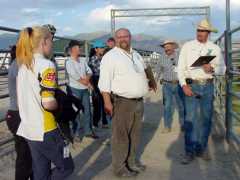|
Boosting the Agricultural Sector
|
Adopters making final bids |
|
Reno, NV
As the debate rages over Senator Conrad Burns' "stealth rider," the question reemerges as to what economic impact the Bureau of Land Management's (BLM's) Wild Horse and Burro Program has on the American economy. The answers are not that hard to uncover. Funds spent on animals typically remain in the agricultural and agri-manufacturing sectors. Money goes to hay growers and their employees, haulers, feed vendors, veterinarians and corral manufacturers, most of which are local private enterprises. These figures are consistent whether the animals are in BLM's care or in the care of private adopters. If, for example, the BLM spends $10 million on its National Wild Horse and Burro program, most of that money will be returned to the agricultural sector. The actual return is proportional to BLM's program budget for any given year. But by far the most significant economic benefits are derived from the decisions thousands of adopters have made to acquire horses and burros and maintain them. From this vantage point, the annual taxpayer investment in BLM's Wild Horse & Burro Program becomes the gift that keeps on giving with respect to our economy. At the end of calendar year 2005 American adopters acquired a total of 204,453 animals from BLM since the inception of the adoption program. Based on conservative life expectancies of those animals and low cost averaging for maintaining those animals, one can calculate a benefit to the agricultural sector of over $ 4 billion. Please see Contributions to State Agricultural Economies by Adopted Wild Horses & BurrosThese benefits will only increase as more horses and burros are adopted by American citizens.In a time where economists worry about increased foreign outsourcing of consumer products and services, and the impact of such trends on our economy, it is reassuring that programs exist that motivate Americans to spend substantial portions of their disposable incomes on activities where the money stays in, and benefits, the regions in which it is spent.

Return to Wild Horse Issues and AnswersReturn to KBR Wild Horse and Burro NewsReturn to KBR World of Wild Horses & BurrosGo to other Wild Horse LinksGo To
|
